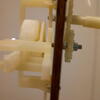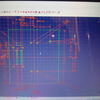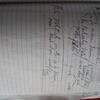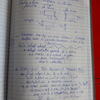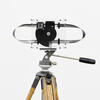Hand to eye - the viewer
In February, Maxime and I set out to copy the mechanism of the 19th Century Cinematograph of the Lumière brothers. The aim is to make a 16mm prototype viewer and multiples for the exhibition HANDS by Akademie der Künste der Welt in Köln.
And eureka! Maxime finds a design by academic BeVer for 3d printing the mechanism. It is designed for 35mm film. We start by copying this mechanism.
a good week later:
It works for a few turns, but we discover that using the 'tige fileté' for the axes is problematit. While turning, it unscrews certain elements fixed on the axe and tightens other elements. We then start using aluminium tubes. We fix the elements on the axes with 'des goupilles' that we plug through holes. Tip: Goupilles seem unfindable in small sizes except on the internet; Conrad delivers precise pieces but you have to wait for delivery approximately 10 days.
In the meantime we redesign the center plate towards 16mm, and try to calculate the adaptation of the sizes of pieces.
3D-printed pieces:
The mechanism gets stuck easily.
What already dawned on un becomes apparent: we need to sand down the pieces of the mechanism, that need to slide over one another, like crazy. A golden tip from Aernoudt of Overtoon helps: put silicon based grease on the pieces.
What was announced to a team of 10 helping hands as a day of assembly of the multiples, turns out to be a whole day of sanding. A nightmare to some, as a few of the fragile printed pieces break in their hands.
We get a prototype to work well, and send it out to Cologne on May 15th.
The parts of the boxes are cut with the lasercutter. Alas, the ventilation is broken. We go at a slow, smelly pace. When finally the new piece arrives and Xavier has installed it, the cutting pace goes up again.
Another assembly day with a team to help. This time, most hours go into peeling protection off plexiglas, screwing the filmholder elements onto the central plates, drilling and assembling the central axes.
The final assemblage is night work; on tuesday Maxime, on wendesday me spend a big part of the night assembling. In the haze of that night, I think about the incalcuble hours we have spent on this mechanism that is still faulty. It was too early to reproduce the prototype into multiples, the axes and plastics not strong enough to make it run soundly. I fantasize about a contest with a traditional blacksmith _ would they get the job done better and faster? ... to be continued.
For Fablab visitors: we left one assembled piece at Fablab.
A great many thanks to Xavier, Colin and Stéfan of Fablab. Without this residency support, we would never have pulled off such an (over)ambicious project. We have been able to learn a lot, it was a superb experience and such a cool place to work in!
And infinite thanks to all those who came to help with the sanding, screwing and assemlage: Loes, Deniz, Michael, Nicolas, Anaïs, Barbara,
This residency has been supported by Cocof
Info
FabLab residency
Date: February 2021 - July 2021
Last updated: March 2022
